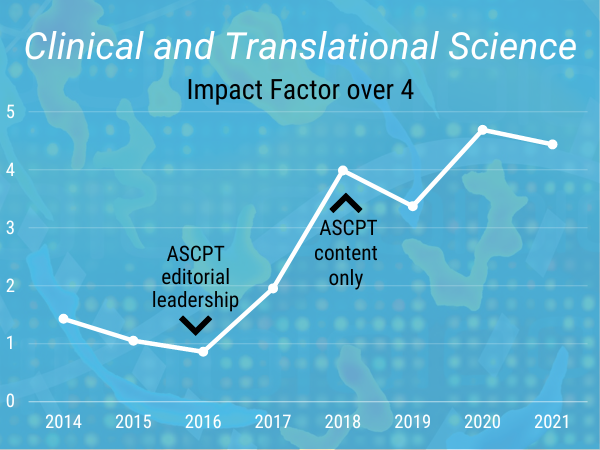Author: John A. Wagner, MD, PhD on August 30, 2022 
The most recent impact factor (IF) numbers are in, and Clinical and Translational Science (CTS) clocked in with an impressive 4.438. As you can see from the graph above, the CTS IF has trended up over the time frame the journal has been published under the banner of ASCPT and now has been over 4 for two years in a row. The positive IF trend confirms that the new CTS content and editorial strategy – with a goal of becoming the beacon for the field of translational science – have continued to be effective.
As a translational scientist and an editor, I like to think of IF as a “biomarker” of the influence and intellectual rigor of the published research. IF is a way of assessing journal performance by calculating how often researchers cite journal papers. Here’s how IF works: Clarivate Analytics, the organization that publishes the Journal Citation Reports, which includes the IF, calculates the number of current year citations of articles published in the two previous years, which is then divided by the number of articles published during those two years.
Clarivate has continued a planned change to how they calculate IFs. Historically, only articles published in assigned volumes/issues would be included in this calculation (both for the numerator and denominator). However, this left some ambiguity for articles that had their initial publication date (what Clarivate calls the “Early Access (EA)” publication date) in a different year than their issue publication date. In the 2020 IF, all content published as EA in 2020 contributed to cited references for the 2020 IF numerator. That calculation tended to increase IF generally. For the current 2021 IF and for the future, all EA articles published in the current contribute to the journal’s denominator in the subsequent IF calculations. Increasing the denominator generally decreases IF, but for many life science and medical journals, that tendency was contravened by COVID-19 publications that garnered many citations.
The three most-often cited papers for the current 2021 IF period were:
In contrast to papers most-often cited in prior CTS IF periods, which were largely reviews, none of the three top cited papers for the current year’s IF were reviews. Two of the articles were on COVID-19, an indicator of the importance of COVID-19 research in current scientific publishing. The most-often cited article was an important work on consensus recommendations for standardizing CYP2D6 genotype to phenotype translation from the Clinical Pharmacogenetics Implementation Consortium and Dutch Pharmacogenetics Working Group. That said, CTS continues to welcome solicited and unsolicited reviews, mini-reviews, and tutorials relevant to the CTS scope, across therapeutic areas and within translational science domains, including, but not limited to, basic research, preclinical research, clinical research, clinical implementation, public health research, reverse translation, and evaluation of all categories of biomarkers.
IF is not the only way to measure journal influence. Other metrics of impact include the number of downloads, which also demonstrated strong results last year in 2021. Downloads are an obvious impact metric that measures how often journal readers take the time to download an article. Downloads demonstrated an even more apparent effect of COVID-19 research on CTS publishing. The three most downloaded articles published in 2021 were:
The CTS editorial team would like to thank CTS authors and readers, the ASCPT membership, and the many folks who make the journal work, including our terrific peer reviewers, as well as ASCPT and Wiley staff. CTS authors are creating the quality content that is ultimately cited in the scientific literature, driving the growing interest in translational science and clinical pharmacology communities. The journal owes its success to all of you. The vision for CTS is to become the beacon and organizing principle for the field of translational science. The laser focus and implementation of this vision has driven the new IF results and remains well-aligned with the ASCPT Strategic Plan. Please continue to help drive our impact and submit to CTS!

The comment feature is locked by administrator.